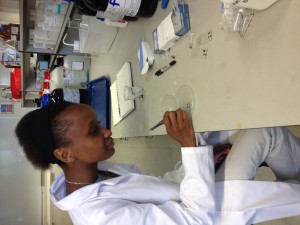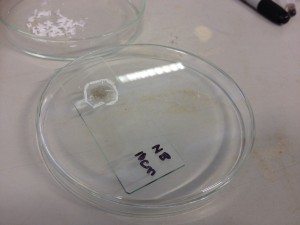Accumulated sediments contain plant macro and microfossils; lakes, swamp and bog sediments trap evidence from the surrounding environments for paleoenvironmental reconstruction. The plant microfossils provide evidence of historical changes in the surrounding environment. These sediments are the indicators studied in palynology which is concerned with the structure and formation of the pollen grains Pollen analysis can be carried out on surface or core sediment to provide information on vegetation composition. When contiguously sub sampled down a core, the broad vegetation changes can be identified.
Pollen processing requires some training due to the reagents used. There are several methods in place but all are modifications from the process described by Faegri and Iverson (1989). Described below is the swirling technique that i will follow while processing at the University of York.
PROCEDURE:
- Sub sample 1-3 cm3 into 100 ml beakers.
- Add 20-25 ml 10% KOH. For absolute analysis add a known volume of Lycopodium spores (tablets with a known number of spores). Boil gently while mixing on a hot plate to facilitate peptisation for about 5minutes. Stop boiling/lower temperature when the samples start to spatter.
- Sieve over 200-250µm mesh screen into 15 ml polypropylene centrifuge tubes. Use disposables to avoid contamination or soak them in bleach (bleach dissolves pollen). Centrifuge for 1 minute at 2000 rpm, decant the liquid, wash twice with deionized water. Add 2-3 ml water, vortex the rack thoroughly on the mixer, top up with water and centrifuge (1min, 2000rpm).
- If carbonates are present add 1 ml Ethanol + 1 ml H2O. Vortex the samples. Add 1 ml 96% Acetic acid, mix carefully ad leave overnight. Wash twice the next day.
- ACETOLYSIS: Wash twice with acetic acid (add 2 ml, vortex, top up with 4 ml Acetic acid centrifuge and decant the clear liquid). Add Acetolysis mixture 96% H2S04: Acetic anhydride (1:9). Vortex, heat gently in aluminium block heater to about 100°c. Vortex the tube and heat further for 5-10 minutes. Centrifuge and decant acetolysis mixture and wash twice.
- HEAVY LIQUID SEPARATION: use Sodiumpolytungstate (3NaWO4.9WO3.H2O with d=2). Add 3ml of the heavy liquid, (Always add sodium polytungstate in portions to water, not vice versa, in order to expedite formation of solution).vortex. Carefully add some water using a glass rod to prevent mixture of the two liquids. Centrifuge at 3000 rpm for 1 minute (organic suspension layer will appear at the boundary between the heavy liquid and water).
- Carefully transfer the organic suspension to another test tube. Water wash twice. Save and filtrate heavy liquid for and the first washing for recycling.
- Transfer to residue tubes using 96% alcohol, centrifuge and decant. Add glycerine/silicone oil (same volume as residue). Evaporate in stove at 60°C.
- Mount the pollen slides.
- SLIDE PREPARATION:
- Stir the residue (pollen+glycerine/silicone oil) and using a teat pipette put a small drop on a microscope slide (label the slide).
- To seat the slide using paraffin wax, put small bits of the wax around the sample. Put cover slip on and place on a hotplate (100°c).
- When all the wax melts take the slide of the hot plate and place on a cooling rack.
Fægri, K., and Iversen, J., 1989, Textbook of Pollen Analysis, New York, John Wiley and Sons. Inc.

